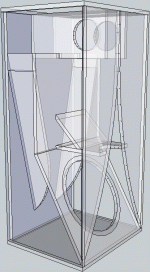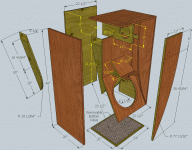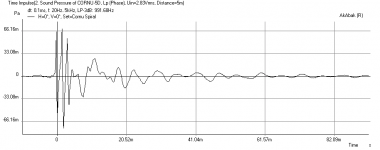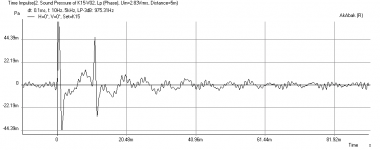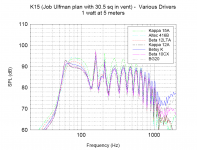it would be interesting to see what can be done by making longer path K-tapped-horn hybrid - any ideas?
You really wanted me to post it all over again that much?
Or just didn't see "longer path K-tapped-horn hybrid" in
it properly the first time?
When the horn can inside can grow no bigger, the Karlson
slot expands the rest of the way into the room. Unprovable
"BS Tie" theory anyway. Believe it or don't...
I can't approve this upper chamber shape is likely to reverb,
but meets all the other criteria...
Attachments
Last edited:
That's pretty cool. And somewhere I recall Moray built those little "muffler" TL rear-chamber jobs, too.
from what little I've played with simple/tall K-type, I think if anything, there was less tendency to "reverb" vs a cupped upper reflector and slant port board - my kludge was rickety, was one-fold with not a lot of area at the top bend and a similar 3/4 wave suckout to my skinny nineleaves style pipe - it did sound pretty good with a little K-tube all the way on top -- - need to lose the dip - I listened to it with full height slot - not the one in the picture. Look how the little X15 copy with 12cx emphasized groundplane dips - 115BK with its larger vent, etc. doesn't do that behavior.
48" tall K-mess vs X15 copy
48" one-fold skinny tapped pipe for 15" woofer response
48" tall K-mess vs X15 copy
An externally hosted image should be here but it was not working when we last tested it.
48" one-fold skinny tapped pipe for 15" woofer response
An externally hosted image should be here but it was not working when we last tested it.
Last edited:
When the horn can inside can grow no bigger, the Karlson
slot expands the rest of the way into the room. Unprovable
"BS Tie" theory anyway. Believe it or don't...
Believe it or not, but I've been looking at the Karlson aperture in the same manner for some time. Especially the simple K-Tube which performs well lower than I'd expect based on horn equations, but it may still be BS. 🙂
IG
You had similar stub in your RJ drawing. We may think too much alike.
If I could reshape the upper chamber to bounce the washplate and
focus on the front slot. Without blocking the transition from horn to
Karlon, then might be worth a go as full range. As drawn, I think it
might only be useful for the lows, or with a KTube to help the highs
bypass the boxy upper chamber.
Really, I would rather test the reflector theory on a full range coaxial
without K-tube exit cheat. And keep all volumes and areas to the K-15
proven values. Change as few things as possible, else when it screws,
we won't have any clear idea which change was to blame.
If I could reshape the upper chamber to bounce the washplate and
focus on the front slot. Without blocking the transition from horn to
Karlon, then might be worth a go as full range. As drawn, I think it
might only be useful for the lows, or with a KTube to help the highs
bypass the boxy upper chamber.
Really, I would rather test the reflector theory on a full range coaxial
without K-tube exit cheat. And keep all volumes and areas to the K-15
proven values. Change as few things as possible, else when it screws,
we won't have any clear idea which change was to blame.
Wow. Some interesting work going on.
To me, the interesting thing about the Karlsons is their front loading. That appears to be where the feeling of effortlessness and power comes from. If I were "going back to fundamentals", I'd find a way to retain this. One approach would be to design a tapped horn, and modify the exit so that it's a K-slot instead of a rectangle.
The original DBR rear loading of the K15 is not really their strongest aspect anyway, though it does more or less work. (IMHO 😉)
I am looking at tapped horns as a starting point too but feel that the Karlson really is operating on a different principle as it has very good cone movement control whereas the tapped horn just lets loose with no cone movement control at the low frequencies and you will blow your driver if low frequencies hit hard.
You really wanted me to post it all over again that much?
Or just didn't see "longer path K-tapped-horn hybrid" in
it properly the first time?
When the horn can inside can grow no bigger, the Karlson
slot expands the rest of the way into the room. Unprovable
"BS Tie" theory anyway. Believe it or don't...
I can't approve this upper chamber shape is likely to reverb,
but meets all the other criteria...
I would model this but it is too complicated being full blown 3d passages. Maybe one day when I have lots of time...🙂 is there a fully dimensioned set of drawings that will let me get all the critical dimensions from?
how rough is it to model "this"? https://www.youtube.com/watch?v=mupb8X6iZ6I - the driver is buried deeper than Ultra Fidelity type - I jammed an extended K-tube down the Eminence coax horn. In pa use a klam would be inverted from this position and mounted on a high stand or ceiling as were Karlson's units for Radio City Music Hall.
David A. Young posted opinions and data at Job Ulfman's Karlson Speaker Project forums. Dave said the Karlson had the advantage over horns as it does not unload the cone below cutoff. Dave made for PA, a cabinet about the size of a Cerwin-Vega B36 (3'x2'x2') - it had very good distortion performance but had a deep dip which can happen in some Ks. What was the cause of that dip? one of my K-type did not have much of one. IIRC, the vent in the drawing below was 6" x 6" and centered in the upper board
my guess from Dave's description
my guess from Dave's description
An externally hosted image should be here but it was not working when we last tested it.
how rough is it to model "this"? https://www.youtube.com/watch?v=mupb8X6iZ6I - the driver is buried deeper than Ultra Fidelity type - I jammed an extended K-tube down the Eminence coax horn. In pa use a klam would be inverted from this position and mounted on a high stand or ceiling as were Karlson's units for Radio City Music Hall.
I don't know what a klam is. Is that just a K aperture mounted in front of a driver like a front horn? I have wondered why people don't make flower petal shaped front horns to utilize a K slot for front horn?
Karlson's first "klam" (named for a clam shaped pattern) was the little KR5 "Rocket" . Karlson sold a 6"x9" stand alone asymmetric projector, a 15" driver version with Altec 421 and K-tube, and a 10" projector. Both the 10" klam projector and 15" klam projector were manufactured and sold by Karlson's good friend Jess Oliver. Karlson's klams were series vented including the little Rocket. There was also a metal ceiling klam called the AP9C.
Rocket ad
http://imageshack.us/a/img809/3239/rocketsheetfront.jpg
Karlson's APX size sold by Oliver Sound as PHASE III
http://i665.photobucket.com/albums/vv12/FUCHSAUDIO/POWERPROJECTOR.jpg
Lars Moseholm's measurements of the little Alan Weiss 8" speaker "Rocket" klam which was loaded with a Radio Shack whizzer cone fullrange.
http://img200.imageshack.us/img200/6531/27139794.jpg
rough sketch of klam8 http://img685.imageshack.us/img685/4966/smallklam.jpg
AP9C ceiling speaker dimensions
http://img507.imageshack.us/img507/460/ap9cviewlsa0.jpg
Rocket ad
http://imageshack.us/a/img809/3239/rocketsheetfront.jpg
Karlson's APX size sold by Oliver Sound as PHASE III
http://i665.photobucket.com/albums/vv12/FUCHSAUDIO/POWERPROJECTOR.jpg
Lars Moseholm's measurements of the little Alan Weiss 8" speaker "Rocket" klam which was loaded with a Radio Shack whizzer cone fullrange.
http://img200.imageshack.us/img200/6531/27139794.jpg
rough sketch of klam8 http://img685.imageshack.us/img685/4966/smallklam.jpg
AP9C ceiling speaker dimensions
http://img507.imageshack.us/img507/460/ap9cviewlsa0.jpg
Last edited:
Is this a 'Good' Impulse Response?
I am looking at the impulse response of a Karlson vs several other speakers. Below is the impulse for the K15 with a Betsy K driver vs a very large (3 ft square) wall mounted Cornu spiral driven by a tiny (compared to Betsy) 5 in Tang Band W5-1611. I am comparing these two very different speakers because I was surprised that it can achieve a very nice 50 Hz to 100 Hz bass shelf at 5 meters with average 88 dB efficiency at 1 watt.
So when looking at impulse response functions, which one would you say is "better"? I think the K15 has a 'clean' single after spike, but with longer time delay of 10 ms and lots of little ripples. The Cornu on the other hand, has several smaller after spikes, but they are all very close together. Will this give a more 'diffuse' bass signature whereas the K15 is a sharp punchy bass signature with what we call 'Kick'? The 'Kick' term seems to often be used to described the Karlson, and I wonder of the cleanliness (sharpness) of the second spike is the reason? Hence why the Karlson kicks butt 🙂
You have all seen the freq response sims of the K15 with Betsy so I will not post it again. The first plot is the freq response of the Cornu, the second plot is the impulse response of the Cornu, and third plot is the impulse response of the K15.
I am looking at the impulse response of a Karlson vs several other speakers. Below is the impulse for the K15 with a Betsy K driver vs a very large (3 ft square) wall mounted Cornu spiral driven by a tiny (compared to Betsy) 5 in Tang Band W5-1611. I am comparing these two very different speakers because I was surprised that it can achieve a very nice 50 Hz to 100 Hz bass shelf at 5 meters with average 88 dB efficiency at 1 watt.
So when looking at impulse response functions, which one would you say is "better"? I think the K15 has a 'clean' single after spike, but with longer time delay of 10 ms and lots of little ripples. The Cornu on the other hand, has several smaller after spikes, but they are all very close together. Will this give a more 'diffuse' bass signature whereas the K15 is a sharp punchy bass signature with what we call 'Kick'? The 'Kick' term seems to often be used to described the Karlson, and I wonder of the cleanliness (sharpness) of the second spike is the reason? Hence why the Karlson kicks butt 🙂
You have all seen the freq response sims of the K15 with Betsy so I will not post it again. The first plot is the freq response of the Cornu, the second plot is the impulse response of the Cornu, and third plot is the impulse response of the K15.
Attachments
I would model this but it is too complicated being full blown 3d passages. Maybe one day when I have lots of time...🙂 is there a fully dimensioned set of drawings that will let me get all the critical dimensions from?
Pretty sure that drawing gave all dimensions that weren't obvious
by addition or subtraction. The wood was 3/4 inch if not obvious...
You can check any uncertain dimension against original sketchup.
Bottom panel is missing, should be exactly the same as top panel...
Attachments
Last edited:
in the real world and with stronger/more durable drivers than the little BetsyK , K15 could play "pretty loud" on drumkit, kick drum and genre with fast double kickdrum. K15 can be jaw-dropping for its ease under a big transient event - vocals on K15 are good too. Willem Norloos had tears from his K15s - not of despair, but of appreciation for a speaker which sounded good and could achieve 130dB. K15 is a cool and innovative design - I'd like to find someone to cut some 0.8 scale couplers to round out my collection.
how does K15 look in simulation with the popular Eminence 12LTA? - a K-tube tweeter or helper tweeter could be added. A small diameter compression driver could set on K15's shelf without too much blocking of the vent flow.
how does K15 look in simulation with the popular Eminence 12LTA? - a K-tube tweeter or helper tweeter could be added. A small diameter compression driver could set on K15's shelf without too much blocking of the vent flow.
I don't know what a klam is. Is that just a K aperture mounted in front of a driver like a front horn? I have wondered why people don't make flower petal shaped front horns to utilize a K slot for front horn?
GregB has a nice flower petal horn sketched for a 1" CD IIRC, maybe he'll post it if he catches this.
IG
Comparison of different drivers in K15
Here is the 1954 K15 (Job Ulfman adapted) plan with reduced 30.5 square inch vent, fitted with all the drivers that I have modeled so far. The Betsy being a "baby" driver actually fares quite well compared to some the more "pro" drivers. If you want ultimate kick it looks like the Kappa 15A is the way to go but at expense of as deep bass extension. 94 dB with 1 watt at 5 meters is pretty impressive anyway you look at it.
how does K15 look in simulation with the popular Eminence 12LTA?
Here is the 1954 K15 (Job Ulfman adapted) plan with reduced 30.5 square inch vent, fitted with all the drivers that I have modeled so far. The Betsy being a "baby" driver actually fares quite well compared to some the more "pro" drivers. If you want ultimate kick it looks like the Kappa 15A is the way to go but at expense of as deep bass extension. 94 dB with 1 watt at 5 meters is pretty impressive anyway you look at it.
Attachments
12LTA looks very comfortable in K15 - if I can move enough stuff around I'll load 12LTA for evaluation and add a K-tube helper tweeter. All of this really amounts to nothing as very few will try a Karlson but are giddy about reflex and pipe. I have some opinions on audio after 50yr of piddling.
it looks like Kappa12A (which I have) would like a smaller coupler than K15.
it looks like Kappa12A (which I have) would like a smaller coupler than K15.
Last edited:
I am not a fanboy of the K but found its simulated performance quite astonishing. This is the reason I started this thread is in hopes of getting more folks to try it out. So far, I can count the folks who have a Karlson in this forum on one hand 🙂. If I were to build one now, I would go all out and get the Kappa 15A and a CD with K tube. Maybe build a tapped horn sub to handle sub 50 Hz.
I am not a fanboy of the K but found its simulated performance quite astonishing. This is the reason I started this thread is in hopes of getting more folks to try it out. So far, I can count the folks who have a Karlson in this forum on one hand 🙂. If I were to build one now, I would go all out and get the Kappa 15A and a CD with K tube. Maybe build a tapped horn sub to handle sub 50 Hz.
i always wonder why, if a design/product is so good, do more people not use it?
in the case of the karlson cabs, they seem to be very rarely used and i've still struggled to find any real reasons why one would use them or why one wouldn't use them.
I have an old diy six slit vent K12 loaded with a Lafayette SK58 coax - its simply beautiful on great voices such as Pavel Lisitsian. Its not like I've not heard and owned direct radiators, planar, horn and electrostat.
some of the biggest offenders to fidelity are direct radiators imo - including some FR
some of the biggest offenders to fidelity are direct radiators imo - including some FR
Last edited:
- Home
- Loudspeakers
- Full Range
- A Speaker that Kicks Butt in Large Spaces
